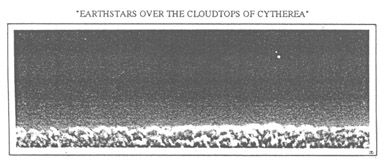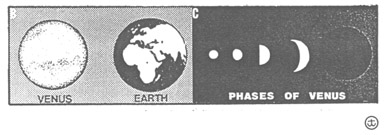VENUS: THE DAY STAR
An Introduction to the Cytherean World
by J. Timothy Unruh, Copyright Ó 1994

Once every 19 months or so, and abiding for a number of weeks, a brilliant star appears in the western evening sky shortly after sunset. Sometimes mistaken for the landing lights of an approaching jet airliner, or even a UFO, this object exceeds every other celestial luminary in brightness, save the Sun and Moon. This glorious evening ornament identified with Aphrodite, the ancient Greek goddess of love, because of its sprightly changes of appearance, and sometimes referred to as Cytherea in a similar association, has most commonly been known in our time as Venus. In a few short weeks after its evening apparition Venus appears as a morning star in the eastern sky before sunrise. The Greeks, baffled by its strange behavior, supposed it to be two planets, so they named the dawn Venus “Phosphorus,” and the evening Venus ”Hesperus.” This brightest of all “stars” has captivated man's attention since the beginning of history. Because of her changeable and enigmatic nature a feminine association was attached to her very early. Even though she continued to evade mankind under her opaque veil of clouds she was destined to be revealed in her true self as radar observations were made and as photographic reconnaissance was made by special techniques via space probes in the past 30 years.
Venus, a wandering star or “planet,” which makes beautiful appearances or “conjunctions” with the Moon is actually not a star at all but a physically solid world as is the Earth. In fact Venus is so near the Earth in size and mass that it has been regarded as Earth's twin sister. Yet the similarities between the two do not go much further than that. Venus, second planet outward from the Sun, is our nearest planetary neighbor and during its closest approach comes to within 26,000,000 miles of Earth, or a little over 100 times the distance of the Moon. If one knows when and just where to look it may be seen to the unaided eye during the daytime. It is the only celestial object apart from the Sun and Moon whereby this is readily possible. A modest telescope or even a 10 power binocular will often reveal the “Daystar” as a crescent shaped object, depending upon its positional geometry relative to the Sun and the Earth, during its orbital progression. In fact, it is recommended that Venus be observed telescopically during the day for reduced contrast and clearer definition. Caution should be exercised, although, when aiming a telescope anywhere near the direction of the Sun lest an eye endangering accidental glance of its magnified hot face should occur during a search for Venus. The phase sequence of Venus is probably its most interesting characteristic for a telescopic observer. In spite of its rather uninteresting featureless cloudy face the planet is undoubtedly a pleasing daytime sight in a blue sky!
Venus played an integral role in the drama of the Copernican revolution. In 1611, at the time of the dawn of telescopic astronomy, Galileo Galilei published one of his concealing anagrams: “Haec immatura a me iam frustra leguntur: o.y.” which when decoded and translated to English reads, “The Mother of Loves (Venus) imitates the phases of Cynthia (the Moon)”, a fact of important cosmological consequences which stirred lively interest in Venus. Galileo's telescope revealed that Venus simulated all the phases of the Moon indicating that it revolved around the Sun rather than revolving in an “eddy” between the Sun and Earth, hence not always remaining in a region always between us and the Sun after all, as held by adherents to the Ptolemaic system of the cosmos. Yet, the phenomena of Venus did not enthrone the Copernican model. The revelations of Galileo's observations were also compatible with the Tychonic arrangement which essentially had all the planets except the Earth revolving around the Sun and then, together with the Sun, around the Earth. In time it was shown that the predictions, observations, and mechanics of the new theory were not sufficient to settle the argument and that a decision between the two systems had to be based on other grounds, and these had little to do with Venus. Thus an Earth centered concept of the universe was still just as reliable to explain the ap pearances as the new Solar centered idea. The ultimate truth of the matter, from a strictly scientific point of view, remains technically unanswerable even though the Copernican scheme has long been adopted by modern science. Perhaps it should be remembered that the purpose of the ancients in their invention of cosmological schemes was not to find a hypothesis that was intended to describe reality, which in the eyes of many of them was available only to the gods, but to describe the phenomena that could be seen and to enable them to make predictions based on the hypothesis used to represent nature. Modern science really does no more. The “laws” man makes in his “discovery” of nature through his science are merely mathematical or mechanical models that describe how nature behaves not why or what nature “actually” is. True science, especially in astronomy, strives to find representations that accurately describe nature and not absolute truths. This fact distinguishes science from the offices of Divine revelation, apart from which mortal man could hardly expect to understand the true nature of the created universe.
Perhaps because of its obscurity some of the greatest and most spectacular contributions of radar astronomy have been made in the study of Venus. The determination of Venus' axial rotation, long a mystery, was not possible via telescopic observation. For a planet like Mars with visibly distinct surface features the determination of its rotation and axial orientation was a relatively easy task. Yet from cloud shrouded Venus came disclosures possible only by the use of penetrating radar technology. Radar echoes reflected from the Cytherean surface yielded much more than the dimensions of its solid globe. A range-Doppler analysis disclosed that Venus rotates in a retrograde direction, counter to its direction of revolution about the Sun, which was a most unexpected result. Even more astonishing is the fact that its axial rotation period of 246.16 Earth days causes Venus to show the same face toward Earth at successive inferior conjunctions, that is, when Venus is directly between the Earth and Sun. A remarkable resonance represented by the synodic period and axial rotation of Venus with respect to the Earth strongly suggests the evidence of a tidal coupling between the two bodies although the specific mechanism(s) that could produce such an effect is obscure and constitutes a real challenge to our understanding. The recent Venus orbiting Magellan probe equipped with imaging radar mapped the entire planet and revealed a contorted topography with a striking variety of intriguing surface features, including volcanoes, impact craters, and other anomalous formations.
The brightness of Venus is perhaps the planet's most outstanding visible attribute as seen from Earth. Outshining the brightest star, Sirius, by a dozen times, Venus is entirely covered with dense light yellowish- hued clouds which give it a high albedo, or reflectivity. Specifically, albedo refers to the fraction of the total light received which is reflected by an object such as a planet. The albedo of Venus is .76 which means that it reflects 76 percent of the light which falls upon it from the Sun. This is the greatest albedo of any planet. By contrast, the Moon, which has the reflectivity of fresh laid road asphalt, has an albedo of .07 and the Earth with its partially clouded atmosphere has an albedo of .39, which is about half that of Venus. Owing primarily to the planet's relative nearness, in a telescope Venus exhibits the largest angular size of any planet. Even if viewed at only 40 power its apparent diameter will equal that of the Moon as seen with the naked eye. Because it always remains in the general direction of the Sun this brightest of all planets never appears in a ”high” sky position at night, thus the backyard observer must often negotiate trees and roof-tops in order to see it.
A visitor would find Venus a very inhospitable place. Instead of a
vast world wide ocean, tropical greenhouse, or spherical Sahara as envisioned
by earlier speculators, the planet has shown to have an exceedingly
hostile climate. Even though the desert hypothesis is the closest to
the truth, it pales as a representation of the actual harsh reality. The environment
there is marked by a conspicuous absence of life-giving water,
an abundance of poisonous carbon dioxides and monoxides, a surface
temperature of many hundreds of degrees Fahrenheit and a monotonous
homogeneous climate that is a veritable hell. Furthermore the incessant
”rain” of sulfuric acid under an atmosphere that exerts nearly 100 times
the pressure at sea level on Earth, presents an intimidating prospect for
the design of future spacecraft that might operate under such an environment.
Venus' surface gravity is .87, and a young woman, for example,
who weighed 100 pounds on Earth would weigh 87 pounds on Venus.
On the brighter side of things, an astronaut in a spacecraft in orbit around
Venus would be able to look back toward the Earth out of his craft's portal
window and see his home, “queen of the terrestrial worlds,” in
”opposition” or directly opposite the Sun, every fifth Cytherean solar day.
At such time the full Earth subtending 70 arc seconds of angular extent
would appear in the midnight sky over the cloud tops of Venus as an exceedingly
brilliant dazzling blue star at apparent visual magnitude of -5.6,
far brighter than Venus ever appears from Earth. At never more than half
a degree to one side of the Earth “star” or the other would appear the ever
attendant imperceptibly oscillating Moon as a first magnitude star.
Venus is mentioned several times in the New Testament as either the morning star or the day star in reference to its typological significance as a representation of Christ. In the Bible every heavenly object apart from the Sun and the Moon is called a star. Only one of these is bright enough to be seen in the daytime, and hence is sometimes called the day star, thus is the planet Venus. “We have also a more sure word of prophesy; whereunto ye do well that ye take heed, as unto a light that shineth in a dark place, until the day dawn, and the day star arise in your hearts” -II Peter 1:19. Preceding the daylight is the daystar, Jesus Christ. As surely as the day follows the rising of the morning star, we know that God will come to rule on earth, bringing peace and light, because Jesus has arisen in the hearts of His people. The fullness of this solidly Biblical symbolism is not exhausted yet, for the majesty of the heavens simply typify the pre-eminent glory of the Lord Jesus Christ, the “bright and Morning Star” (Revelation 22:16), whose second coming shall usher in the age of righteousness and peace, for He is the “Prince of peace.” Without Christ the world cannot have peace, for only righteousness can bring peace. As the morning star rises, as if from the darkness of death unto the heavens above, “God hath both raised up the Lord, and will also raise up us by His power,” “...and make us sit together in heavenly places in Christ Jesus” — I Corinthians 6:14; Ephesians. 2:6.


Draw three boxes in a row flush along the bottom of a sheet of paper. Label these from left to right as “A,” “B,” and “C. Above that row of boxes draw another row of three boxes and label these three boxes from left to right as “C,” “B,” and “A.” Is it possible to draw lines connecting the bottom boxes with the correspondingly labeled top boxes without the lines crossing each other?